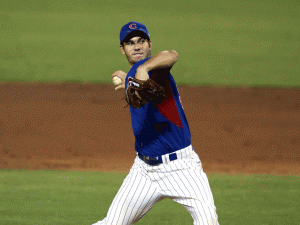
A Primer on High-Ceiling Pitchers in the Cubs’ Low Minors
In an effort to look inward for the pitching depth the Cubs need to develop, we first covered pitchers likely to make an impact at the major league level in the 2016 season. Today we’ll be looking at pitching prospects in the low minors with top-of-the-rotation ceilings. Familiarize yourself with these names, as they all have the potential to take a huge leap forward next season.
Oscar de la Cruz
De la Cruz made the biggest jump of any Cubs pitching prospect this season, beginning the year in extended spring training before skipping over the AZL and pitching in the Northwest League for the Eugene Emeralds. This was his first taste of life in the US, as he had been pitching in the Dominican Summer League for the previous two seasons. Signed for $85,000 as a 17-year-old in 2012, the big-bodied (6’5”, 200 pounds) righty has some athleticism and is projectable.
His current fastball sits in the 90-93 range with heavy sink and is aided by the great plane he develops due to his height. Between that and his curveball that flashed plus in the second half of the season, de la Cruz has some of the best pure stuff in the system. His changeup is still in its infancy, but he has a clean and repeatable delivery. The development of his changeup and consistency with his curveball will be key for him next season.
De la Cruz struck out 73 batters in 73 innings in the Northwest league as a 20-year-old. His stature and arsenal scream mid-rotation starter. If his changeup develops and he adds a couple ticks to the fastball, he could be the front-of-the-rotation arm the Cubs have been looking for. Stay on the lookout for his name at South Bend next year as he has the potential to take a huge leap forward.
Dylan Cease
Selected in the 6th round of the 2014 draft out of high school in Georgia, Cease did not honor his commitment to Vanderbilt and signed for $1.5 million. He was projected as a first round pick before suffering an elbow injury four months before the draft. Immediately after he was chosen, he underwent Tommy John surgery, recovering quickly enough to pitch 24 innings in the Arizona League this season.
Cease’s fastball returned to its pre-injury velocity, consistently sitting at 95-96 mph and topping out at 99. Usually the last thing to come back from TJ is command, and that was certainly the case with Cease. When on, he throws a plus-plus fastball and a low-80’s curveball that will flash average with potential for more. He also has a changeup that he rarely threw this year. Cease’s arm speed is very impressive, and it allows him to generate mid-90’s velocity. However, there is effort to his delivery and he doesn’t quite have the developed body you’d expect from a starting pitcher.
Cease is just 19 years old though, and to recover that quickly from TJ surgery is impressive. If the Cubs are feeling optimistic about his development over the winter and spring, he could start in South Bend, although I wouldn’t be surprised if they held him back in extended spring training until the Northwest League starts.
Bryan Hudson
An alumni of Alton High School in Illinois, Hudson was drafted in the 3rd round of this year’s draft and signed for $1.1 million. He stands 6’ 8” and uses his size to develop a great plane on his fastball. He barely began his first professional season, accumulating just 6.2 innings in the AZL.
In high school he was sitting at 86-90 mph and topping out at 92 with his fastball. With his physique, arm action, and athleticism for his size, that number has the potential to increase significantly. Hudson’s best pitch at the moment is his devastating low-80’s power curveball. Cubs scouting director Matt Dorey told Baseball America it is one of the best amateur curveballs he has ever scouted. Because the fastball/curve combo was so devastating in high school, Hudson didn’t need to use his changeup, but that’s something he’s been developing in the offseason thus far.
The development of Hudson’s fastball is key for him next season, and he’s likely to start in a short-season league (either AZL or Northwest league) of some sort.
Justin Steele
Of the three large bonus babies — along with Carson Sands and Dylan Cease — of the 2014 draft, Steele has had the strongest start to his Cubs career. He threw 41 innings for the Emeralds, striking out 31 and allowing 13 walks. His ERA was an impressive 2.66 for a 19-year-old going against a lot of players just drafted out of college. He has a projectable frame and plus velocity at the moment.
Steele’s fastball topped out at 95 mph this season and normally sits in the 90-92 range. His present command is fringe-average due to a lot of extra motion in his delivery, but if he can tone it down a bit the fastball could improve. He also spins a very good curveball with 12-7 movement that flashes above-average. His changeup is very far behind the other pitches as he noticeably slows his arm down, but he can throw it for strikes. Overall, it’s an intriguing package and, like the other players mentioned so far, he has the potential to be a #3 starter if he hits his ceiling.
Carson Sands
In terms of rankings, Sands is slightly behind Steele at the moment, but he has as much potential as anyone. This season for the Emeralds, Sands pitched 57 innings, striking out 41 and walking 21. His ERA was fairly high at 3.92, but that was largely inflated by a start where he went 1/3 of an inning and allowed nine earned runs.
Sands’ arsenal consists of a fastball with arm-side run that operates in the 90-95 mph velocity band. He touched 95 this year and showed solid command of the pitch. He also throws a curveball that has flashed plus in the past but is very inconsistent now due to its shape. His changeup flashes average but is also very inconsistent. There’s a lot of work for Sands to do to reach his potential as a starter, but right now he’d make a decent reliever.
We’re hoping to get eyes on the South Bend staff, which could include Sands, Steele, and de la Cruz, this coming season. All very projectable arms that have the highest ceilings of any Cubs pitchers in the system.

